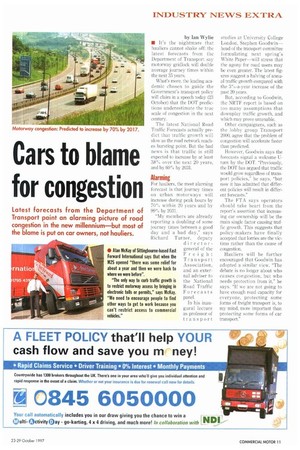Cars to blame for congestion
Page 13

If you've noticed an error in this article please click here to report it so we can fix it.
Latest forecasts from the Department of Transport paint an alarming picture of road congestion in the new millennium—but most of the blame is put on car owners, not hauliers.
by Ian Wylie • It's the nightmare that hauliers cannot shake off: the latest forecasts from the Department of Transport say motorway gridlock will double average journey times within lie next 35 years.
What's more, the leading aca(mi i c chosen to guide the (;)vernment's transport policy will claim in a speech today (23 October) that the DOT predictions underestimate the true scale of congestion in the next century.
The latest National Road Traffic Forecasts actually predict that traffic growth will slow as the road network reaches bursting point, But the bad news is that traffic is still expected to increase by at least 38% over the next 20 years, and by 60% by 2031.
Alarming
For hauliers, the most alarming forecast is that journey times on urban motorways will increase during peak hours by 70% within 20 years and by 99% by 2031.
"My members are already reporting a doubling of some journey times between a good day and a bad day," says Richard Turner, deputy directorgeneral of the Freight Transport Association, and an external adviser to the National Road Traffic Forecasts panel.
In his inaugural lecture as professor of transport studies at University College London, Stephen Goodwin head of the transport committee formulating next spring's White Paper—will stress that the agony for road users may be even greater. The latest figures suggest a halving of annual traffic growth compared with the 3%-a-year increase of the past 20 years.
But, according to Goodwin, the NRTE report is based on too many assumptions that downplay traffic growth, and which may prove untenable.
Other campaigners, such as the lobby group Transport 2000. agree that the problem of congestion will accelerate faster than predicted.
However, Goodwin says the forecasts signal a welcome Uturn by the DOT. "Previously, the Dar has argued that traffic would grow regardless of transport policies," he says, "hut now it has admitted that different policies will result in different forecasts."
The ETA says operators should take heart from the report's assertion that increasing car ownership will be the main • single factor causing traffic growth. This suggests that policy-makers have finally accepted that lorries are the victims rather than the cause of congestion.
Hauliers will he further encouraged that Goodwin has adopted a similar view. "The debate is no longer about who causes congestion, but who needs protection from it," he says. "If we are not going to have enough road capacity for everyone, protecting some forms of freight transport is, to my mind, more important than protecting some forms of car transport."
• Alan McKay of Sittingboume-based Fast Forward International says that when the M25 opened "there was some relief for about a year and then we were back to where we were before", "The only way to curb traffic growth is to restrict motorway access by bringing in electronic tolls or permits," says McKay. "We need to encourage people to find other ways to get to work because you can't restrict access to commercial vehicles."
















































































































